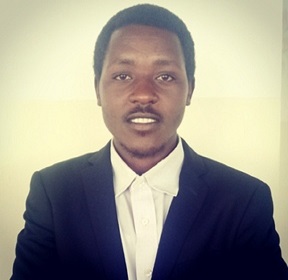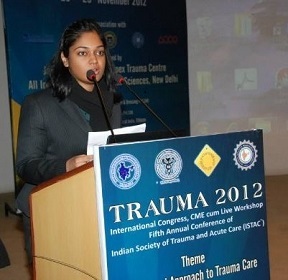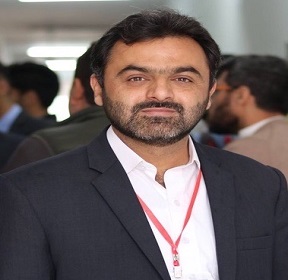Speakers
Jimmy Nkaiwuatei
Jomo Kenyatta University of Agriculture and Technology KenyaTitle: The use of genetic interference mechanisms in treatment of human genetic disorders
Abstract:
Gene interference can be defined as the alteration of the activity of specific genes by altering the regulatory sequences. Gene therapy aims at treating genetic diseases through insertion and expression of specific exogenous genetic materials by transfer of nucleic acids either in vivo or in vitro (through modified cells). This results to expression of a normal product thus correcting the abnormal cellular function. Gene therapy involves two approaches which include germ-line and somatic line gene therapy. In germ-line gene therapy, the germ cells are integrated by exogenous functional genes which can be transferred into the offspring’s while in somatic line gene therapy, the genes are introduced into the patients’ somatic cells and the effects are only experienced on that particular individual. Both methods leads to reduction in the coding mRNA levels. RNA interference not only inhibits transcription, but also induces an RNA degradation process. Gene silencing is enhanced by presence of double stranded RNA (dsRNA) molecules and is initiated by the dicer enzyme, where the dsRNA are cleaved by the protein into small interfering RNA (siRNA) strands which can prime the mRNA of the coding genes to form a duplex (siRNA + mRNA). The duplex activates the RNA-induced silencing complex (RISC) which upon activation degrades the duplex with the critical coding sequences. This is very essential in gene silencing. This gene degradation mechanism thus blocks the process of translation thus inhibiting expression of abnormal proteins responsible for the genetic diseases.
Biography:
Jimmy Nkaiwuatei holds a Bachelor of Science in Biochemistry and Molecular Biology from Jomo Kenyatta University of Agriculture and Technology (JKUAT), Kenya. He is the founding Partner, Find Your Voice Science club and currently the head of Drug Research, Discovery and Innovations Program at Students against Superbugs Africa. He is also a member of Young African Leaders Initiative (YALI).Jimmy Nkaiwuatei holds a Bachelor of Science in Biochemistry and Molecular Biology from Jomo Kenyatta University of Agriculture and Technology (JKUAT), Kenya. He is the founding Partner, Find Your Voice Science club and currently the head of Drug Research, Discovery and Innovations Program at Students against Superbugs Africa. He is also a member of Young African Leaders Initiative (YALI).
Dr Aparajita Kumar
American College of Cardiology IndiaTitle: SUCCESSFUL THROMBOLYSIS BY LOW DOSE SLOW INTRAVENOUS ALTEPLASE INFUSION IN CRITICALLY ILL PATIENTS WITH STUCK PROSTHETIC MITRAL VALVE:A CASE STUDY
Abstract:
Prosthetic valve thrombosis(PVT) contributes to significant post valve replacement mortality and morbidity.Treatment guidelines are controversial,ranging from surgical intervention to thrombolysis.We report a case study of two challenging patients who presented in our hospital,known Rheumatic Heart Disease,Post Mitral Valve Replacement,with Acute Left ventricular failure in NYHA class IV and PVT,of which one had coagulopathy with grossly deranged INR.Both patients were put on intermittent non invasive ventilator and inotropic supports,and successfully thrombolysed with low dose slow intravenous Alteplase infusion given every 6 hours in discrete doses with monitoring of PT/INR and mitral valve gradients,resulting in remarkable clinical improvement .Their successful treatment shows that thrombolysis can be considered as an effective treatment modality in high risk surgery patients with stuck prosthetic mitral valve.
Biography:
Dr Aparajita Kumar has completed Diploma Cardiology in 2015 from MS Ramaiah Narayana Hrudalaya, Bangalore,,and is an International Associate, American College of Cardiology.She has over 7 years experience in Cardiology having previouly worked in leading corporate hospitals,,and is presently working as Consultant Cardiology-Non interventional in Max Hospital Dehradun, India.She has attended several national and international conferences,and has been a presenter in International Trauma Conference.She had been awarded Second prize in National Young Genie Champion in Cardiology in 2016.She has a keen interest in research,and completed Research to Publication course by UCMS California and BMJ for designing clinical trials and scientific writing,and was awarded 200 CPD credits for the same.Her key interests are Preventive cardiology, echocardiography and hypertension
Taherah Mohammadabadi
Agricultural Sciences and Natural Resources University, Iran IranTitle: Nutraceutical Supplements for Diabetes and Its Complications
Abstract:
Diabetes mellitus is linked with cardiovascular diseases and kidney and liver failures. Although the proper treatment of diabetes includes insulin injection continuously to maintain blood glucose, but nowadays, the researchers following some adjunct natural therapy for diabetes. Bioactive components of herbs and camel milk as nutraceutical supplements can be effective on diabetes and cardiovascular and liver failures. Ginger can directly increase glucose uptake that may be beneficial for type 1 and type 2 diabetes. Using cinnamon in type 2 diabetics for 40 days decreased the blood glucose and lipids of diabetic patients. It is proved that Fenugreek seeds lower blood glucose in diabetes patients by insulinotropic effects of alkaloids. Dietary supplementation of 10 g Fenugreek/day in diabetes cases decreased insulin resistance. Nettle increase insulin sensitivity in muscle and fat cells, thereby increasing glucose uptake into cells and subsequently lower blood sugar. Colocynth was administered three times a day in type 2 diabetes patients, and reduced fasting blood sugar and lipids and glycosylated hemoglobin, increased insulin secretion from pancreatic cells. However, silymarin reduces insulin secretion without causing high blood sugar, and this effect can be helpful in treatment of hyperinsulinemia in type 2 diabetes. Phenolic compounds in Moringa may be to some extent responsible for the anti-diabetic and antioxidant properties. Camel milk contains insulin like proteins, which can be absorbed from the intestine and may be an effective alternative for insulin to treat type 1 and 2 and gestational diabetes. Camel milk may prepare about 60% of the insulin in diabetic patients and reduce blood sugar and required insulin dose. Obviously, camel milk is effective on insulin receptor function, signaling and glucose transport in the insulin-sensitive tissues, and insulin secretion. Herbs and camel milk improve the diabetes complications such as obesity, inflammation, wounds and oxidative stress damages. The anti-oxidative activity of herbs and camel milk whey proteins enhance the proliferation of immune cells and accelerates the wound healing process during diabetes and improve liver failures and lipid profiles in diabetes patients. Due to the side and temporary effects of chemical drugs, the use of bioactive components of herbs and camel milk as nutraceutical supplements along with chemical drugs is recommended for diabetics. But more scientific studies are needed to confirm the effectiveness of these supplements on diabetes cases.
Biography:
Taherah Mohammadabadi finished her PhD in Iran and Australia and has been as a researcher at University of Queensland, Australia; she has attended and presented her works in different conferences in some countries. She is working as academic member, researcher and teacher since 11 years ago in Faculty of Animal Science and Food Technology, Agricultural Sciences and Natural Resources University, Iran. She has been as supervisor for 10 PhD students and more than 30 Msc students. She has over 200 published publications, conferences presentations, and scientific projects; Also, some books on phytochemicals and microbes, bioactive components in the livestock milk; milk lactoferrin and health, anti-diabetes properties of camel milk. She is member of the editorial board and reviewer of some international and national journals.
Shruti Dabi
Rajasthan University of Health Science IndiaTitle: Comparative evaluation of role of Oro-t mouthwash and Smf mouthwash as adjunct to scaling (subgingival irrigation): A randomized clinico-comparative study”
Abstract:
Treatment of periodontal disease is routinely based on mechanical debridement of the tooth surface and appropriate and meticulous maintenance of oral hygiene. However, comprehensive mechanical debridement of sites with deep periodontal pockets is difficult to accomplish, therefore systemic or local administration of antibiotics are preferred. But there are various disadvantages with systemic therapy like hypersensitivity reaction, organ toxicity and bacterial resistance. So, to attained the correct required GCF concentration at the target site, led to the use of local drug-delivery system. Ayurveda system of medicine has its root in Indian subcontinent which is being globalized and practices as alternative medicine in the Western world. It is typically based on complex herbal compounds, minerals, and metal substances. Further SMF mouthwash has been used for treating OSMF patient because of its contents which enhanced its properties by improving healing capacity of the tissue. So, in this present study we have planned to evaluate & compare healing potential of both the mouthwashes which is better
Biography:
Shruti Dabi. she has completed my master in dental surgery in the year Aug, 2021 from Rajasthan University of health science, Jaipur (Raj.). Presently She Has practicing her field of specialty in her private clinic held in Ajmer (Raj.) India with her dad’s named as Vikram Singh Dabi. she had published 2 original research in international PubMed journals & 1 book in international journal, others are under process. Presently she is working with 4 different journals, as an Editor in 2 international journals [1 dental (PubMed journal) & 1medical (Scopus journal)] & as a Reviewer in 2 international dental journals (Scopus, publons).
Najeeb Ullah Khan
The University of Agriculture, Khyber Pakhtunkhwa PakistanTitle: Significant association of BRCA1, BRCA2 and TP53 gene polymorphisms with breast cancer risk in Khyber Pakhtunkhwa, Pakistan
Abstract:
Molecular characterization of breast cancer heterogeneity facilitates the understanding of disease etiology and progression. More specifically, mutations in known and tumor suppressor genes such as BRCA1, BRCA2 and TP53, result in the alteration of a genomic landscape within sporadic and familial breast cancers. Single nucleotide polymorphisms (SNPs) are described as a mutation with a particular prevalence in certain ethinic population that in turn result in the altered prevalence of disease, the tumor suppressor genes responsible for maintaining the genomic stability. Certain SNPs in BRCA1, BRCA2 and TP53 are known to correlate with elevated risk of breast cancer development worldwide, however there is no such study categorizing the risk of breast cancer development in the Khyber Pakhtunkhwa population in Pakistan.
Biography:
Najeeb Ullah Khan have a Ph.D. in Biochemistry and Molecular Biology. Recently, He is working on human genetic variability and susceptibility to cancer. His focus is to find the most associated gene polymorphism with cancer risk in our region and check the potential of that particular gene polymorphism as a biomarker for disease monitoring, especially cancer early diagnosis, particularly breast cancer. So far, they have confirmed the association of BRCA1&2, TP53, RANKL, OPG, IL-6, HER2 etc) polymorphisms with breast cancer risk in our population (Pashtun ethnicity). Several other related studies are under process in breast and other cancer including the association of noncoding RNA (microRNAs) with cancer risk. Interested in any kind of research collaboration in the field of cancer Biology, cancer genetics and cancer early diagnosis.





